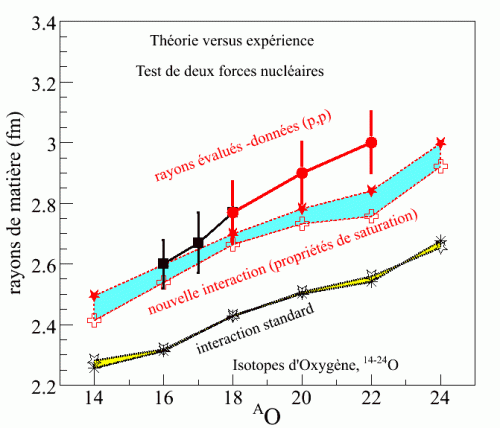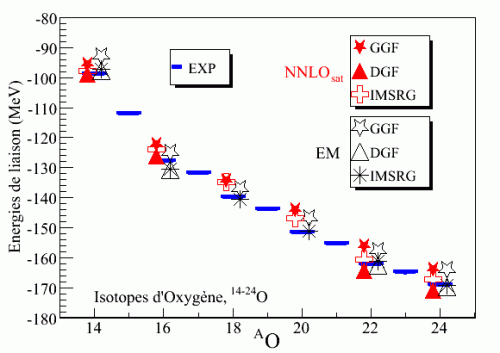The comparison of ab initio calculations and experimental data was the subject of original work initiated by physicists from the Nuclear Physics Department of the CEA-Saclay: for the first time, this study combines two types of fundamental observables of the nucleus: mass (binding energy of the fundamental state) and size in terms of nuclear radius, in the form of the mean square radius of the density of matter (all nucleons, protons and neutrons), and the proposed comparison is extended to the most neutron-rich isotopes. This work, published on July 27, 2016 in Physical Review Letters, was presented as a "highlight from the editor", and the results highlight the key observables on which to build our general understanding of the description of atomic nuclei, by linking them to ab initio forces. The comparison with several computational techniques was carried out in collaboration with theorists from the University of Surrey, Triumf, and MSU.
“ab initio” objectives for understanding of the nuclear structure
One of the fundamental objectives of nuclear physics is to obtain a description of the properties of the atomic nucleus (mass, structure, spectroscopy, reactions) based on modelling based on elementary interactions, i.e. interactions between the components of the nucleus protons and neutrons. These approaches are referred to as "ab initio". They apply to the structure and spectroscopy of low-energy nuclei, with the scale of our studies ranging up to about 10 MeV and, in general, up to about 100 MeV for reaction models. Achieving such a unified description with ab initio interactions would be an essential step towards a better microscopic understanding of known nuclei, both the stable (286 known) existing in the natural state on Earth, as well as the unstable ones created around the world with radioactive beam accelerators (~3300). The decisive consequence would then be to reliably predict the existence and characteristics of the thousands of unobserved nuclei: depending on the models, it is expected to discover between 2000 and 3000 new unstable nuclei. With the means of production at our disposal, most of them cannot be reached in the laboratory, even in the distant future. However, they are involved in nuclear reactions in the heart of stars, and their properties are crucial to understanding the nucleosynthesis processes of heavy elements. This indeterminacy on the possible number of exotic nuclei is related to our lack of knowledge of the characteristics of systems weakly linked to large isospin[Tz = (N-Z)/2; Z, N, A the numbers of protons, neutrons, mass of the nucleus]. To date, these systems are not reliably calculated with the nuclear forces at our disposal. On the one hand, it is necessary to base a description of the strengths on the first principles, and on the other hand, to examine how to build forces that will produce results that are consistent with experience. This means that it is necessary to determine the observables on which we can effectively compare experimental data with the results of the calculations, to test the validity of interactions, and thus improve our theoretical tools.
The interest and originality of the study lies in the confrontation of experience-theory, for these two types of observables, going as far as possible from the valley of stability. This work was initiated on the basis of discussions held in March 2014, during a workhop organized by DPhN physicists as part of the ESNT, to compare observables of mass, radii and spectroscopy, for oxygen and calcium isotopes.
As part of our work, we evaluated the experimental values of the radii of matter from the data sensitive to the size of the nucleus: the effective sections of elastic diffusion on proton, available for oxygen isotopes in the literature. Elastic scattering calculations are performed at DPhN from the optical scattering model, and using, for nucleus-proton interaction, a microscopic potential model depending on the nucleus' proton and neutron densities. The first calculations of the ab initio material radii were performed at DPhN.
Then, we carried out ab initio calculations based on the combination of several expertises and techniques implemented by a collaboration of theoretical physicists. The mass results, calculated by the different techniques, using two interactions, allow the approaches to be validated. In recent years, work has shown the role of the contributions of 3-body interactions in understanding the evolution of oxygen isotope masses and the binding limit at N=16 to 24O, the last bound isotope known experimentally: masses are correctly reproduced when calculations include the contributions of three-body forces, crucial to explain the limit at N=16. In ab initio calculations, once the masses have been correctly reproduced with the forces selected, it is necessary to understand how to reproduce, with the same type of calculations, the observable nuclear radii. Previous theoretical work also examined the validity of three-body forces by focusing on comparison with the charge radii of stable nuclei or nuclei near the valley of stability.
For the first time, in our study, we propose to examine the observable radii of matter extracted from scattering (p,p) by going as far as possible in the field of neutron-rich oxygen isotopes, with the objective of testing the validity of large isospin calculations for two types of interactions. The matter radii bring new constraints on interactions because we can discuss them for neutron-rich isotopes, while the charge radii are limited to the nuclei of the valley of stability.
Ab initio approaches
To test the consistency of all ab initio techniques, calculations were conducted using several approaches to the many-bodyproblem. Without going into detail, these are methods based on different assumptions to treat correlations between nucleons (with controlled approximations of the exact solutions of the Schrödinger equation): GGF (Gorkov Green Function), DGF (Dyson Green's Function) and with the Multi Reference Renormalization Group (MR IMSRG). The discussion is first conducted on the comparison of theoretical results, given by the most modern calculations. It was important to obtain a consistent vision of all ab initio calculations, according to the methods, by performing them with two types of interactions with 2 and 3 bodies (derived from the chiral effective field theory):
- the Entem-Machleidt EM interaction, (black lines). Qualified as standard or conventional because it takes into account data of low mass (less than 4) only, it is constructed with coupling constants adjusted on light nuclei,
- a new NNLOsat (red). Developed to take into account the saturation properties of nuclear material, its adjustment of coupling constants is based on data from the 12C and 16O nuclei. These ingredients are likely to improve the agreement on the radii.
The various calculations are in good agreement on the binding energies (Fig. 1), for both interactions, regardless of the many-body approach, and dripline is well reached at N = 16.

Figure 2. Comparison between the matter radii from experimental evaluation with those obtained from ab initio calculations using two types of nuclear interactions. The colored bands present the envelop with the GGF and IMSRG calculations.
Comparison of experimental radii to calculations.
For all radii (densities of protons, neutrons and matter), the results of the calculations give two distinct series, depending on the interaction. For the matter radii, in the case of the two interactions (Fig. 2), the bands, yellow for the conventional interaction, EM, blue for the new one, NNLOsat, represent the extended radius area, corresponding to the results of the calculations carried out with the different techniques. For the same interaction, the calculations, derived from the different correlation treatments, give consistent results.
The evaluation of the matter radii of the nuclei is carried out using the angular distribution data of the elastic scattering on proton target (p,p) obtained with 18,20,22O oxygen beams and measured with the MUST multi-detector of charged light particles, during experiments dedicated to elastic and inelastic scattering on proton target. These measurements have been collected over the past 10 years at GANIL using radioactive oxygen beams produced by fragmentation at energies ranging from 35 to 50 MeV. In Figure 2, the black squares show the estimated radii of matter deduced from the charge radii obtained for stable isotopes by electron scattering, the red dots are the radii evaluated from the scattered radioactive beams on the proton target. For the stable isotope 18O, evaluations are available from a set of measurements in the literature: the proton density radius can be extracted from electron scattering, and the material radius from elastic scattering on proton, performed in direct (proton on 18O target) or inverse kinematics (an 18O beam sent on proton target).
Results and conclusions.
The article shows the relevance and precision of ab initio formalism for the theoretical description of nuclear structure and mass understanding, while emphasizing the need to improve approaches to 2 and 3-body interactions to understand the matter radii of the most neutron-rich nuclei: conventional nuclear interactions do not provide a realistic description of the charge and matter radii. A new version of the forces considerably improves the description of the three observable forces for stable nuclei, but remains deficient for the systems with the highest neutron content. The development of the nuclear interactions used must face this crucial challenge from the simultaneous understanding of observables to very neutron-rich systems.
Charge radii are not sufficient, as they are currently only available for stable nuclei or those close to the stability valley. Radioactive electron-ion collision programs could extend the knowledge of charge radii (see a recent ESNT workshop on this subject). For unstable nuclei far from the valley of stability, when we can have beams intense enough to perform scattering on proton, we obtain their matter radii. A systematic programme would be essential to carry out extensive measurements, both in terms of charge and matter radii, up to the nuclei with the highest neutron content. Moreover, if we are to develop truly microscopic approaches to reactions, as amplitudes and interactions evolve with size, simultaneous reproduction of masses and radii is essential to consider a unified treatment of structure and reactions for all nuclei, stable and unstable.
Our paper thus provides new results that can be used to identify observables that play a key role in building our general understanding of the description of atomic nuclei and to test the reliability of large isospin nuclear interactions as part of ab initio calculations. It highlights the importance of developing measurement and calculation programs on these complementary observables: the mass and radius of the matter density.
Contacts : and CEA DRF, IRFU, DPhN
Publication : "Radii and binding energies in oxygen isotopes: a challenge for nuclear forces
Physical Review Letters 117, 052501 (2016), article published on July 27th 2016 as “Editor’s suggestion”
Authors : V. Lapoux (CEA-Saclay), V. Somà (CEA-Saclay), C. Barbieri (University of Surrey), H. Hergert (NSCL, MSU), J.D. Holt (TriumF) and S.R. Stroberg (TRiumF).
Nuclear Physics, DOI: 10.1103/PhysRevLett.117.052501
Electronic version: https://journals.aps.org/prl/pdf/10.1103/PhysRevLett.117.052501
arxiv link Nuclar Physics http://arxiv.org/abs/1605.07885
This work was initiated in the framework of a workshop of the ESNT virtual laboratory Theory for Nuclear Structure and reactions" (l’Espace de Structure et de réactions Nucléaires Théorique): http://esnt.cea.fr
Workshop 2014 comparison experiment-ab-initio theory
Workshop 2016, electron-radioactive ion collisions
• Structure of nuclear matter › Atomic nucleus
• The Nuclear Physics Division





